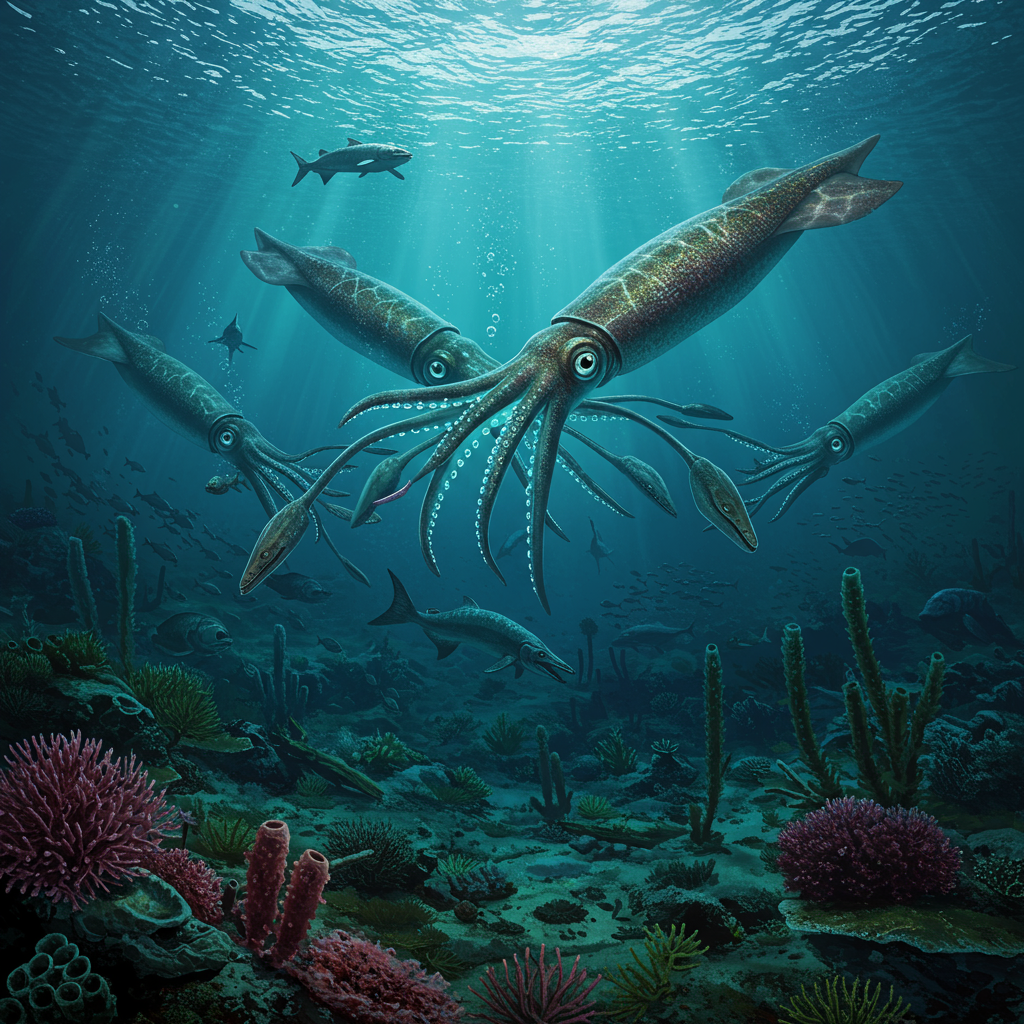marine scientists have made a stunning discovery that rewrites the history of life in the ancient oceans. A recent study published in the prestigious journal Science reveals that squids, often seen as modern marvels of the deep, were in fact dominant predators approximately 100 million years ago. This challenges long-held beliefs about when these intelligent cephalopods rose to prominence.
The groundbreaking research, led by a team at Hokkaido University, utilized a novel method to uncover secrets hidden within ancient rocks. Their findings paint a vivid picture of Late Cretaceous seas teeming with diverse and abundant squid populations, far earlier than previously thought.
Unearthing a Prehistoric Ocean Mystery
For years, scientists believed that squids only truly began to flourish after the massive extinction event that wiped out the dinosaurs around 65 million years ago. This catastrophic period was thought to clear the way for new marine lifeforms, including squids, to diversify and fill ecological niches. However, the new evidence turns this timeline on its head.
The Hokkaido University team discovered robust evidence showing that squids were already widespread and thriving millions of years before the end-Cretaceous extinction. This fundamentally changes our understanding of marine ecosystems during the Mesozoic Era, suggesting that squids played a much more significant role than previously attributed to them. They weren’t just surviving; they were dominating.
How Scientists Found Hidden Squid Fossils
One major hurdle in studying ancient squids is that their soft bodies rarely preserve well as fossils. Unlike their shelled relatives like ammonites, squids typically decompose before fossilization can occur. However, squids possess a hard, chitinous beak, similar to a parrot’s beak, which is much more likely to endure over geological timescales. These beaks provide crucial clues about the squid’s size, diet, and species.
The challenge lies in finding these small, embedded beaks within solid rock. The Hokkaido University researchers developed an innovative approach they call “digital fossil-mining.” This technique involves grinding down rock samples layer by layer while simultaneously taking high-resolution images. These images are then digitally reconstructed to create a complete 3D model of the rock, revealing all embedded fossils without physically extracting them in a potentially damaging way. This method is essentially a form of grinding tomography, offering a detailed look inside the rock matrix.
Using this advanced technique on Late Cretaceous rock samples from Japan, the team was able to virtually explore the ancient sediment. They identified over one thousand fossilized cephalopod beaks. Among this vast collection, a remarkable 263 specimens were identified as belonging specifically to squids.
The Reign of the Ancient Squid
The sheer number of squid fossils uncovered was astonishing. Researchers found that squid beaks far outnumbered those of other marine creatures often considered dominant during the Mesozoic, such as ammonites and even bony fishes. This numerical prevalence alone suggested a much larger squid population than previously estimated for this period.
The size of the ancient squids also surprised the scientists. Based on the size of the fossilized beaks, it was clear that these prehistoric squids were substantial creatures. They were comparable in size to the fish found alongside them and even larger than the ammonites discovered in the same rock samples.
Dr. Shin Ikegami, the study’s lead author from Hokkaido University, emphasized this point. “In both number and size, these ancient squids clearly prevailed the seas,” he stated. “Their body sizes were as large as fish and even bigger than the ammonites we found alongside them. This shows us that squids were thriving as the most abundant swimmers in the ancient ocean.” This evidence strongly supports the conclusion that squids were not just present, but actively functioning as apex predators within the marine food web 100 million years ago.
Challenging the Timeline of Squid Evolution
Beyond their abundance and size, the fossil discovery revealed important details about squid diversity. The 263 squid specimens included approximately 40 different species, many of which had never been seen before.
Remarkably, the study also found evidence that the two major lineages of modern squids, Myopsida (typically found near coastal areas) and Oegopsida (which inhabit the open ocean), had already originated and diversified by 100 million years ago. The presence of these distinct groups so early in history further underscores that squid evolution and radiation occurred much earlier than the post-dinosaur extinction period. Instead of waiting for the extinction event, squids were undergoing significant diversification and expanding into different ecological niches long before it.
This finding compels scientists to rethink the entire evolutionary timeline for cephalopods and, specifically, squids. It indicates that their rapid diversification was not a response to a sudden environmental change 65 million years ago, but rather a process that was well underway tens of millions of years earlier.
Why Squid Beaks Hold Vital Clues
Understanding the evolutionary history of squids has been a major challenge for paleontologists precisely because of the scarcity of complete fossil remains. While ammonites left behind durable shells, and vertebrates left bones, the soft tissues of squids rarely survive the fossilization process. This is why the discovery and analysis of their hard beaks are so significant.
Squid beaks, made of robust chitin, have a much higher chance of becoming fossilized. They act as miniature time capsules, preserving information about the mouthparts and feeding habits of these ancient creatures. By studying beak morphology and size, researchers can infer details about the squid’s species, its place in the food chain, and even its overall body size. The digital fossil-mining technique made it possible to locate and analyze these fragile beaks in unprecedented numbers, providing a wealth of data that would have been impossible to gather using traditional fossil extraction methods.
What This Discovery Reveals About Ancient Marine Ecosystems
The findings from this study have profound implications for how we view the dynamics of prehistoric marine ecosystems. For decades, ammonites were considered among the most successful and prevalent swimmers of the Mesozoic. This new research suggests that squids were not only present but were potentially even more abundant and ecologically dominant swimmers than previously thought.
Associate Professor Yasuhiro Iba, who led the study, commented on the significance: “These findings change everything we thought we knew about marine ecosystems in the past.” He added that ancient squids were “probably the pioneers of fast and intelligent swimmers that dominate the modern ocean.”
This implies that the traits we associate with modern squids – their speed, agility, complex nervous systems, and intelligence – may have provided them with a crucial evolutionary advantage in the crowded, competitive seas of the Late Cretaceous. Their mobility and predatory prowess likely allowed them to thrive and diversify rapidly, establishing themselves as key players and even apex predators within the marine food web long before the age of dinosaurs came to an end.
Instead of being passive components, the study suggests these ancient squids were actively shaping the environment and influencing the evolution of other marine life through predation and competition. This revised understanding highlights the strategic advantages offered by their advanced intelligence and mobility, positioning them as influential figures in the long-term evolutionary narrative of marine life.
Frequently Asked Questions
What innovative method uncovered these ancient squid fossils?
Researchers from Hokkaido University used a technique called “digital fossil-mining,” specifically grinding tomography. This involved progressively grinding away layers of rock samples while capturing detailed images. These images were then used to create a 3D digital reconstruction, allowing scientists to identify and study tiny, fragile fossils like squid beaks embedded within the rock without needing to physically extract them.
How did this study change the timeline of squid evolution?
Before this research, many scientists believed that squids significantly diversified and became ecologically prominent only after the mass extinction event that occurred about 65 million years ago, following the decline of dinosaurs and other marine life. This study provides strong evidence that squids had already originated and were undergoing extensive diversification and becoming dominant predators much earlier, around 100 million years ago during the Late Cretaceous period.
Were ancient squids larger or more numerous than other prehistoric ocean dwellers?
Yes, the study’s findings indicated that ancient squids were both numerous and large compared to other marine creatures found in the same fossil samples. The researchers discovered hundreds of squid beaks, which outnumbered those of ammonites and bony fish. Based on beak size, the ancient squids were estimated to be comparable in size to fish and larger than the ammonites present, suggesting they were abundant and substantial swimmers in the ancient ocean.
Conclusion: Rewriting the Story of Ocean Life
The discovery that ancient squids were dominant ocean predators 100 million years ago is a significant breakthrough in paleontology. Thanks to the innovative digital fossil-mining technique, scientists have gained unprecedented insight into a crucial period of cephalopod evolution. The abundance, size, and diversity of squid fossils found in Late Cretaceous rocks from Japan reveal that these remarkable creatures were thriving and diversifying tens of millions of years earlier than previously thought.
This research not only reshapes the timeline of squid evolution but also fundamentally alters our perception of ancient marine ecosystems. It suggests that squids, with their advanced speed, agility, and intelligence, were key players and likely apex predators that helped shape the prehistoric seas. The study highlights the power of new technologies to unlock secrets from the deep past, urging us to continually question and update our understanding of life’s long and complex history on Earth.




